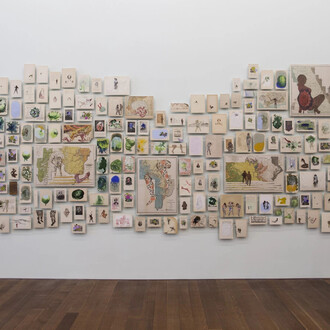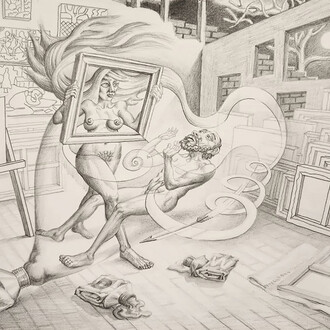Henderson’s newest work furthers her ongoing conceptual investigation of the formation of identity and the self. Veering between series that push the genres of figuration and formalist abstraction into postmodern frameworks, Henderson provides innovative ways to approach an array of pervasive social paradigms by making paintings, which appear and suggest decorative fabric, textile or wallpaper. Arising originally from her own lifelong interest in sewing, fashion and interior design, these enterprises continue to serve her visual practice. Remarkably flat and intricate as if they were mechanically produced, Henderson subverts her painterly hand so the viewer must truly look in order to see and experience its laborious handmade quality and its true import. Persuasively merging form with content, she brings to the fore myriad and complex ideas surrounding superficiality, manipulation, social decoying and patterning. Henderson culls her material from ubiquitous social signifiers and codes, which camouflage their influence in the formation of ourselves in an effort to stimulate and provoke a dialogue toward possible change.
In “Groundwork(s)” in Gallery X, compositions are constructed by the layering of shoe treads. These forms Henderson sources and traces directly from the earth whether imprinted in dirt, mud, sand, rain or snow. Recorded and appropriated as she finds them, “these surface iconographies, a residue that marks us routinely across space in time-prosaic, routine, overlooked, interest [Henderson] as vestigial configurations of our collective history.” Also of fascination, is the degree of design that underlies the making of shoes. Treads are used in forensics to identify and profile a wearer as suspect; they can reflect the migration of groups as in diasporas. Shadows of a human presence blend with these human markers and lend meaning to their credence as social signifiers. Through palette, composition and form, Henderson mimics the mechanisms employed in the branding process, delivering images that imply both a transient and ephemeral commoditization of the self. What is left behind as we move through life? Let us consider.
In “Regard”, the exhibit in Gallery O, Henderson furthers this notion of branding, yet her focus and concern is on the social impact of the media’s representation of the female body and the effect of our cultural obsession with image. Tracing bodily forms found in commercial advertising, and more so, the self-advertising of social media, i.e. the “selfie”, Henderson explores how women, to various degrees, invest in their own objectification to build an image that embodies a powerful self, a narrative of identity. In a series titled “Contours,” Henderson obscures and distorts via the fusion of a variety of all too familiar poses as she thought about how, “the contrapposto stance, a canon of classical Western art, (which) was an embodiment of the ideal of man communicating to viewers of Greco-Roman statuary a state of balance, confidence, and ease in the world. Postures struck by women in selfies posted currently on social media suggest that the pervasive publishing of sexualized tropes, ubiquitous in commercial fashion and celebrity media, have similarly come to function as a type of cultural archive of poses for women/girls to circulate representations of themselves as powerfully attractive and in control.” Does the edifice of the outer self, the distorted, unrealistic attempt to manufacture usually unattainable, idealized body distract and substitute for the value of that within? In her “Eye-Con Frieze” series, Henderson posits the highly stylized and luring female figure as stone like superficial deities carved on temple walls- mere surfaces on an inner-sanctum. Places where heart and soul and real self-worth lays awaiting for realization.
















